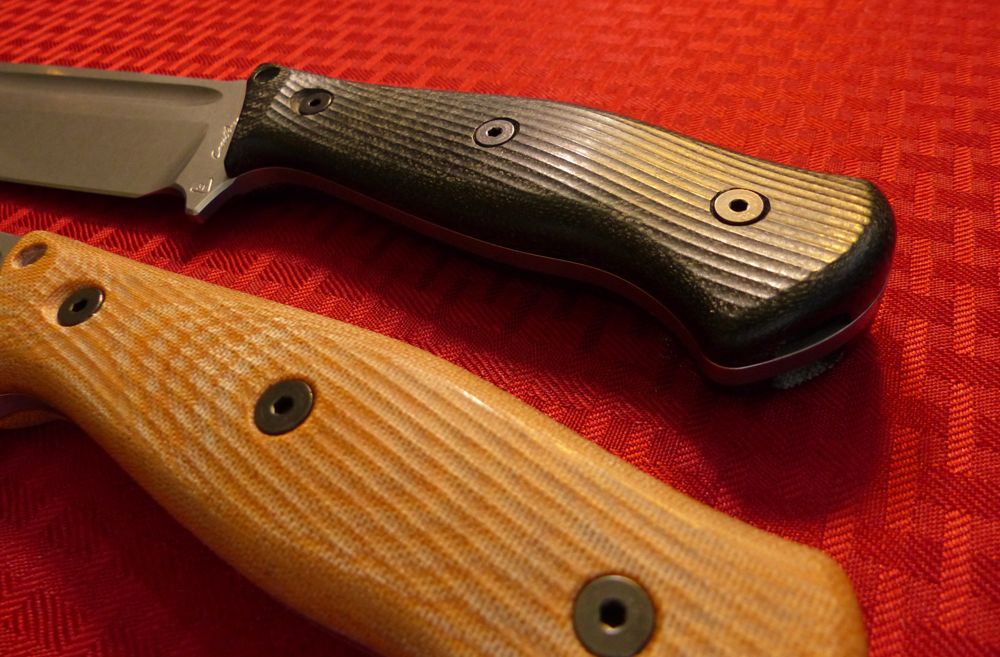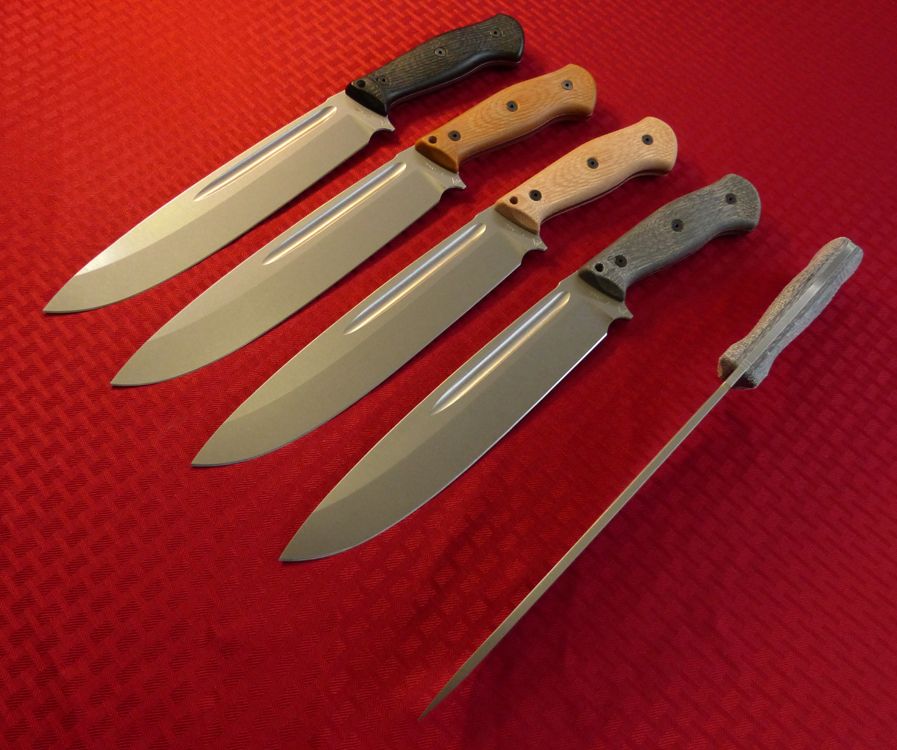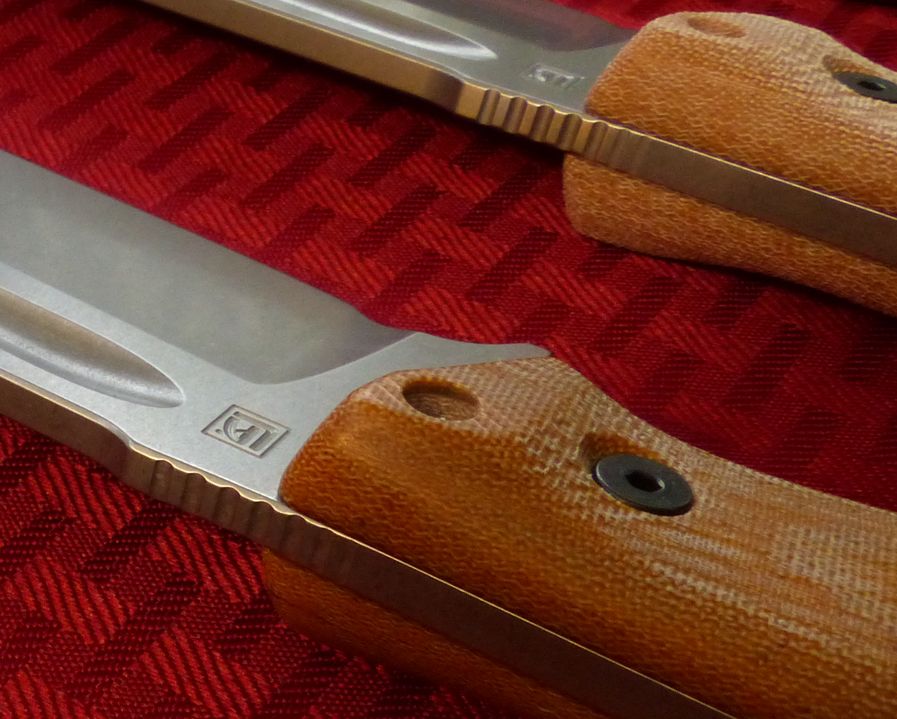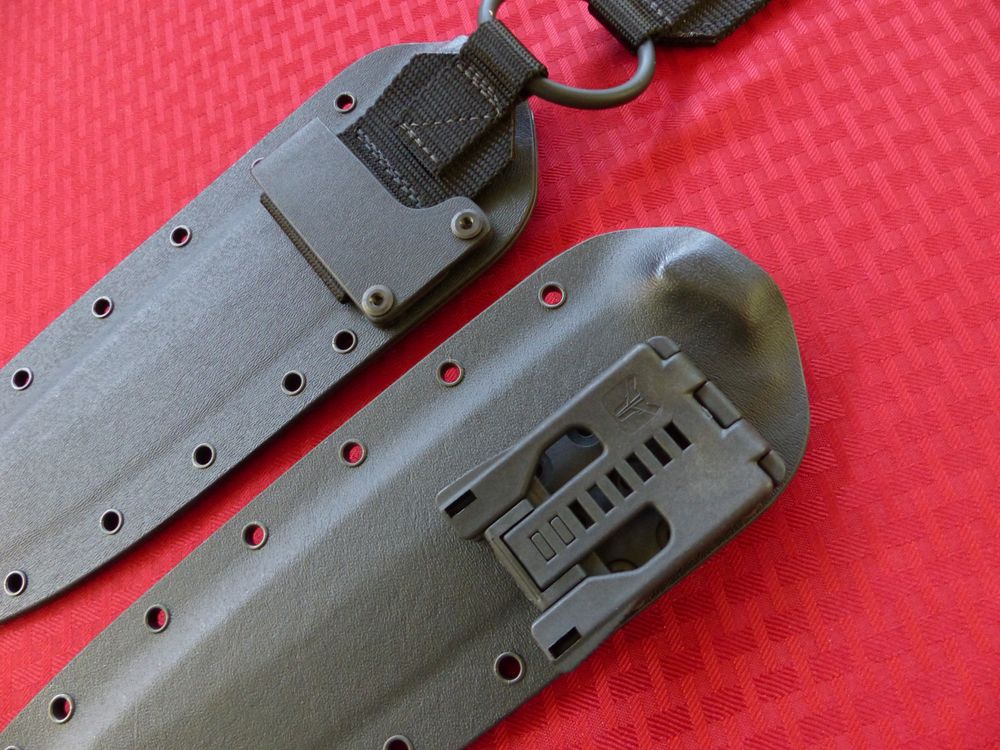Nathan the Machinist
KnifeMaker / Machinist / Evil Genius
Moderator
Knifemaker / Craftsman / Service Provider
- Joined
- Feb 13, 2007
- Messages
- 18,238
Five Light Choppers, 3V, micarta, TeroTuf
This is a "build your own" sale. You choose the configuration you want and I'll build it.
The Light Chopper was a collaboration with Lorien Arnold. It is an exercise in geometry, weight distribution and ergonomics to make a light weight well balanced chopper that hits well above its weight. It's a large woods knife, with a ~10" blade that weighs 17.1 oz that is somewhere between a machete and a camp knife. It's light enough to be carried on a long hike without weighing you down and it's engineered for performance when you go to use it.
It's made of CPM 3V at HRC 60.5 with the newest heat treat for 3V that I believe is the finest heat treat for this material available anywhere. The performance is phenomenal with a combination of toughness, edge durability and edge retention that will blow your mind. A lot of R&D went into developing this heat treat, it is truly different and better.
With that in mind I gave it relatively thin cutting geometry designed for cutting performance. This is not some overbuilt pry bar, it cuts like a demon, but it is very durable, see 2nd video.
It's light enough and long enough to develop tip speed to cut thinner vegetation that heavy choppers struggle with. But when you put it to work in the big stuff you'll find that it hits hard and bites deep and it won't wear you out. The grip and aspects of the cutting geometry were designed in collaboration with Dan Keffeler.
The hand grip works great as a camp knife when held towards the front with good balance and dexterity. When held towards the back it fully fills the hand and offers control and reduced hand and forearm fatigue for extended hard work.
It has a forward lanyard hole (as used in competition cuts) and a hidden rear lanyard hole.
These are available in natural or black micarta. I normally buff the scales, but some people prefer the feel of the scale in matte because it has more grip and the fuzz works better with hand sweat. So it's up to you if you want your micarta scales buffed, just let me know. Unbuffed scales darken from hand oils pretty quickly.
These are also available in TeroTuf. This material is on the competition cutters that are winning championships. It isn't especially pretty or even as dimensionally stable as other synthetics, but nothing else offers a grip quite like it. If you're out there cutting for extended time and your hands are sweaty and slippery you'll appreciate the grip and feel. I have laminated it to black micarta with black Acraglas for dimensional stability.
Be aware, the unbuffed materials aren't about pretty. They will get a little funky looking before they break in but will even out with use.
Light Chopper Specs:
CPM 3V, 60.5 HRC, .188 thick at ricasso
This is the newest "Delta" HT protocol
Total length 15.625
Blade length 9.875
Edge is sharpened 20 DPS
Weight 17.1 oz
Grippy 3D machined scales in micarta or TeroTuf
Black oxide treated 18-8 stainless steel fasteners
$340 without sheath in micarta
$365 without sheath in TeroTuf
Sheath with dangler $80 (only 3 available)
Sheath with TekLok $65
Shipping is $10.
This is a big knife. If you're going to carry it on your belt you might prefer the dangler sheath. If you're putting it on or in your pack you might prefer the TekLok. Both configurations work both ways, but it's nice to have a choice.
Tell me what scale option you choose and I'll build it. There are five knives available in this sale. The knives in the picture are not the knives you will receive. The knives need scales and sharpened so they will not ship until middle of next week.

















Dan doing what Dan does, with an early prototype:
[video=youtube;TvUsh5FijcY]https://www.youtube.com/watch?v=TvUsh5FijcY[/video]
Durability demo:
[video=youtube;yC2PLk_04vE]https://www.youtube.com/watch?v=yC2PLk_04vE[/video]
^ This has an outstanding combination of cutting performance, toughness and edge retention.
These are "field grade" with tool marks, milled and tumbled. The bevels are lightly hand ground and slightly convexed after being milled.
Anyone who has ordered a chopper in a previous sale and wants to get a sheath for it can order one now with free shipping or can contact Dave Brown directly.
Thanks for looking.
Some thoughts about 3V and heat treat:
3V was originally developed for the tool and die industry for difficult stamping applications. The heat treat used in that application, which uses the secondary hardening hump, results in good toughness and abrasion resistance in that application and minimal part growth after heat treat, which is critical in tool and die. But, the carbon lean martensite, secondary carbides and retained austenite that decomposes in temper rather than a part of the primary quench all lead to issues with reduced edge stability in a knife edge. The thin geometry of a knife edge is not found in a stamping tool, and tiny areas of weakness become like the perforations in a postage stamp, allowing an edge to roll over, chip and generally behave "mushy". This sort of thing is so common in today's complex super steels and stainless steels that people just accept it as normal.
We have been tweaking 3V for cutlery for a while now, improving it for knives incrementally. There are a number of versions of these tweaks from me and other makers, but they can all be described as a "low temperature tweak". Basically, it involves avoiding the secondary hardening hump, and when done right reduces structures that are harmful to edge stability, but requires addressing retained austenite without a high temper. A happy side effect of leaving the carbon in the martensite is it doesn't tie up all the chromium, leaving 3V very nearly stainless.
All of my 3V over the years has been tweaked in one way or another.
Last year some of us running a tweaked 3V ran into some trouble with some that didn't respond like we expected. Those of us makers who test work from every batch noticed it. It required some re-work, but we addressed the issue, and it prompted us to try to better understand what was going on with the alloy and to pursue a fully optimized 3V. So, Guy Seiferd (Survive Knives), Dan Keffeler and I invested the time and resources to more deeply investigate variables and develop a more complete understanding of the alloy, its quirks, and develop an optimized heat treat protocol for it. This is one reason my output was low earlier in the year, because I'd spent a significant portion of the winter in R&D mode.
Our previous tweaks to 3V had already made it significantly outperform the industry standard, so the fully optimized version is not a night and day improvement over our previous work, but the difference is significant, so in order to differentiate between this optimized 3V and previous tweaks we are putting a Delta symbol with the 3V on the knife to denote change. Otherwise, it would be difficult to differentiate.

If you're curious, this is a video that illustrates the difference between the fully optimized 3V and an old industry standard heat treat: https://www.youtube.com/watch?v=6imZ4Vo8iwA
The Light Choppers have all received the new Delta 3V heat treat from the beginning. :thumbup:
This is a "build your own" sale. You choose the configuration you want and I'll build it.
The Light Chopper was a collaboration with Lorien Arnold. It is an exercise in geometry, weight distribution and ergonomics to make a light weight well balanced chopper that hits well above its weight. It's a large woods knife, with a ~10" blade that weighs 17.1 oz that is somewhere between a machete and a camp knife. It's light enough to be carried on a long hike without weighing you down and it's engineered for performance when you go to use it.
It's made of CPM 3V at HRC 60.5 with the newest heat treat for 3V that I believe is the finest heat treat for this material available anywhere. The performance is phenomenal with a combination of toughness, edge durability and edge retention that will blow your mind. A lot of R&D went into developing this heat treat, it is truly different and better.
With that in mind I gave it relatively thin cutting geometry designed for cutting performance. This is not some overbuilt pry bar, it cuts like a demon, but it is very durable, see 2nd video.
It's light enough and long enough to develop tip speed to cut thinner vegetation that heavy choppers struggle with. But when you put it to work in the big stuff you'll find that it hits hard and bites deep and it won't wear you out. The grip and aspects of the cutting geometry were designed in collaboration with Dan Keffeler.
The hand grip works great as a camp knife when held towards the front with good balance and dexterity. When held towards the back it fully fills the hand and offers control and reduced hand and forearm fatigue for extended hard work.
It has a forward lanyard hole (as used in competition cuts) and a hidden rear lanyard hole.
These are available in natural or black micarta. I normally buff the scales, but some people prefer the feel of the scale in matte because it has more grip and the fuzz works better with hand sweat. So it's up to you if you want your micarta scales buffed, just let me know. Unbuffed scales darken from hand oils pretty quickly.
These are also available in TeroTuf. This material is on the competition cutters that are winning championships. It isn't especially pretty or even as dimensionally stable as other synthetics, but nothing else offers a grip quite like it. If you're out there cutting for extended time and your hands are sweaty and slippery you'll appreciate the grip and feel. I have laminated it to black micarta with black Acraglas for dimensional stability.
Be aware, the unbuffed materials aren't about pretty. They will get a little funky looking before they break in but will even out with use.
Light Chopper Specs:
CPM 3V, 60.5 HRC, .188 thick at ricasso
This is the newest "Delta" HT protocol
Total length 15.625
Blade length 9.875
Edge is sharpened 20 DPS
Weight 17.1 oz
Grippy 3D machined scales in micarta or TeroTuf
Black oxide treated 18-8 stainless steel fasteners
$340 without sheath in micarta
$365 without sheath in TeroTuf
Sheath with dangler $80 (only 3 available)
Sheath with TekLok $65
Shipping is $10.
This is a big knife. If you're going to carry it on your belt you might prefer the dangler sheath. If you're putting it on or in your pack you might prefer the TekLok. Both configurations work both ways, but it's nice to have a choice.
Tell me what scale option you choose and I'll build it. There are five knives available in this sale. The knives in the picture are not the knives you will receive. The knives need scales and sharpened so they will not ship until middle of next week.

















Dan doing what Dan does, with an early prototype:
[video=youtube;TvUsh5FijcY]https://www.youtube.com/watch?v=TvUsh5FijcY[/video]
Durability demo:
[video=youtube;yC2PLk_04vE]https://www.youtube.com/watch?v=yC2PLk_04vE[/video]
^ This has an outstanding combination of cutting performance, toughness and edge retention.
These are "field grade" with tool marks, milled and tumbled. The bevels are lightly hand ground and slightly convexed after being milled.
Anyone who has ordered a chopper in a previous sale and wants to get a sheath for it can order one now with free shipping or can contact Dave Brown directly.
Thanks for looking.
Some thoughts about 3V and heat treat:
3V was originally developed for the tool and die industry for difficult stamping applications. The heat treat used in that application, which uses the secondary hardening hump, results in good toughness and abrasion resistance in that application and minimal part growth after heat treat, which is critical in tool and die. But, the carbon lean martensite, secondary carbides and retained austenite that decomposes in temper rather than a part of the primary quench all lead to issues with reduced edge stability in a knife edge. The thin geometry of a knife edge is not found in a stamping tool, and tiny areas of weakness become like the perforations in a postage stamp, allowing an edge to roll over, chip and generally behave "mushy". This sort of thing is so common in today's complex super steels and stainless steels that people just accept it as normal.
We have been tweaking 3V for cutlery for a while now, improving it for knives incrementally. There are a number of versions of these tweaks from me and other makers, but they can all be described as a "low temperature tweak". Basically, it involves avoiding the secondary hardening hump, and when done right reduces structures that are harmful to edge stability, but requires addressing retained austenite without a high temper. A happy side effect of leaving the carbon in the martensite is it doesn't tie up all the chromium, leaving 3V very nearly stainless.
All of my 3V over the years has been tweaked in one way or another.
Last year some of us running a tweaked 3V ran into some trouble with some that didn't respond like we expected. Those of us makers who test work from every batch noticed it. It required some re-work, but we addressed the issue, and it prompted us to try to better understand what was going on with the alloy and to pursue a fully optimized 3V. So, Guy Seiferd (Survive Knives), Dan Keffeler and I invested the time and resources to more deeply investigate variables and develop a more complete understanding of the alloy, its quirks, and develop an optimized heat treat protocol for it. This is one reason my output was low earlier in the year, because I'd spent a significant portion of the winter in R&D mode.
Our previous tweaks to 3V had already made it significantly outperform the industry standard, so the fully optimized version is not a night and day improvement over our previous work, but the difference is significant, so in order to differentiate between this optimized 3V and previous tweaks we are putting a Delta symbol with the 3V on the knife to denote change. Otherwise, it would be difficult to differentiate.

If you're curious, this is a video that illustrates the difference between the fully optimized 3V and an old industry standard heat treat: https://www.youtube.com/watch?v=6imZ4Vo8iwA
The Light Choppers have all received the new Delta 3V heat treat from the beginning. :thumbup:
Last edited:
